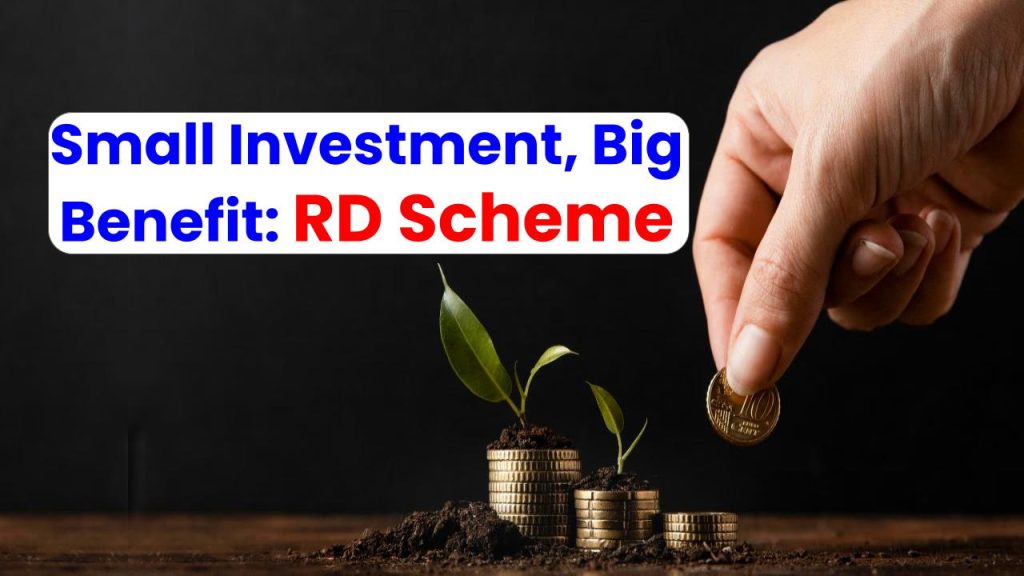
Saving money might feel difficult when you’re just starting out, but did you know you can begin your financial journey with as little as ₹100? Yes, that’s right! With a Recurring Deposit (RD) scheme, you can start small and end big. It’s a smart, safe, and steady way to build your wealth over time — no fancy degrees or financial background required.
Whether you’re a student, a salaried individual, or a retiree, an RD can help you grow your savings bit by bit. Let’s break down how you can make the most of this simple yet powerful investment tool.
Small Investment, Big Benefit: RD Scheme
| Feature | Details |
|---|---|
| Minimum Investment | ₹100 per month (Post Office RD) |
| Interest Rate | Up to 7.25% p.a. (varies by bank/post office) |
| Tenure Options | 6 months to 10 years (depending on bank/post office) |
| Best For | Salaried individuals, students, homemakers, small savers |
Starting a Recurring Deposit (RD) scheme with just ₹100 is a fantastic way to build the habit of saving. It’s secure, earns good returns, and suits people from all walks of life. Whether you’re saving for a rainy day or your child’s future, an RD can be your first step toward financial freedom. So don’t wait for the “right time” to start investing — let your ₹100 today turn into something bigger tomorrow.
What is a Recurring Deposit (RD)?
A Recurring Deposit is a type of term deposit offered by banks and post offices where you deposit a fixed amount every month for a specific period. In return, you earn interest on your deposits, which is compounded quarterly or annually, depending on the financial institution.
Why Choose an RD?
- Safe Investment: RDs are not market-linked, so your returns are guaranteed.
- Flexible Tenure: You can choose tenure based on your goals – from 6 months to 10 years.
- Encourages Habitual Saving: It’s a great way to develop a regular saving habit.
- Loan Facility: Some banks allow loans against your RD balance.
see also: SBI Senior Citizen Investment Plan: Great Investment Plan with Big Returns
Where Can You Start an RD with ₹100?
1. India Post Office RD Scheme
- Minimum Deposit: ₹100/month (in multiples of ₹10)
- Tenure: 5 years
- Interest Rate: 6.7% p.a. (compounded quarterly)
- Account Type: Individual or joint; can also be opened for minors
- Features:
- Premature closure allowed after 3 years
- Nomination facility available
2. State Bank of India (SBI) RD
- Minimum Deposit: ₹100/month
- Tenure: 1 to 10 years
- Interest Rate: ~6.80% to 7.00% p.a.
- Senior Citizen Benefit: Additional 0.50% p.a.
- Features:
- Loan against RD up to 90% of the deposit
- Nomination facility available
3. Bank of Baroda RD
- Minimum Deposit: ₹100/month
- Tenure: 12 to 120 months
- Interest Rate: ~6.75% p.a.
- Features:
- Partial withdrawal not allowed
- Premature closure allowed with interest adjustment
How Much Will You Get? (Example Calculation)
Let’s say you deposit ₹100 every month for 5 years in the Post Office RD scheme at 6.7% interest:
- Monthly Deposit: ₹100
- Tenure: 60 months
- Interest Rate: 6.7% p.a.
- Maturity Amount: Approx. ₹7016
It may seem small, but imagine saving ₹1000/month instead — your maturity value jumps to around ₹70,165. That’s the magic of compounding!
Step-by-Step Guide to Open an RD Account
Step 1: Choose a Bank or Post Office
Decide where you want to open your RD. Compare interest rates and features.
Step 2: Submit KYC Documents
You’ll need:
- PAN Card
- Aadhaar Card
- Passport-size photo
- Address proof (if not on Aadhaar)
Step 3: Deposit First Installment
Pay the first monthly deposit (minimum ₹100 for most banks/post offices).
Step 4: Choose Tenure & Nomination
Pick a tenure (say, 5 years) and provide nominee details.
Step 5: Start Saving Monthly
Set auto-debit instructions so you never miss a payment.
Pros and Cons of RD Schemes
Advantages
- Safe and low-risk
- Great for small savers
- Flexible tenure options
- Predictable returns
Disadvantages
- Lower returns than stocks or mutual funds
- Penalty for missed payments or early withdrawal
- Fixed deposits may offer higher rates for lumpsum
Tips to Maximize RD Returns
- Start Early: The earlier you start, the more you earn due to compounding.
- Be Consistent: Never miss a monthly payment to avoid penalties.
- Compare Rates: Check rates on bank websites before investing.
- Use for Goals: Save for education, emergency fund, or travel.
see also: Home Loan Tips: Easy Ways to Get Rid of Home Loan EMI Before Time
Small Investment, Big Benefit: RD Scheme FAQs
Q1: Can I open an RD account online?
Yes! Most banks including SBI, HDFC, ICICI, and Axis allow you to open an RD through internet banking or mobile apps.
Q2: What happens if I miss a payment?
A penalty will be charged. For example, Post Office charges a default fee of ₹1 per ₹100 per month.
Q3: Can I close my RD early?
Yes, premature closure is allowed but with reduced interest or a penalty.
Q4: Is RD better than FD?
RD is ideal for regular savers. If you have a lump sum, Fixed Deposit (FD) might offer better returns.
Q5: Is the interest from RD taxable?
Yes. Interest earned is added to your income and taxed as per your slab. TDS applies if interest exceeds ₹40,000 in a year (for banks).











